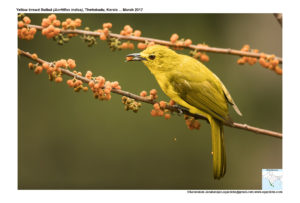
Yellow -browed Bulbul Acritillas indica
Etymology:
- Acritillas: Greek word akritos –confused; illas – thrush. { Thrush like}
- Indica: from India
Vernacular Names: Hindi: Haldi bulbul, Kopi Kuruvi, Pili Bhonho ki bulbul, Sans: Pitta govatsak, Mar: Haldi bulbul, Pivalya bhuvaicha bulbul, Mal: Manjachinnan, Sinh: Kaha kondaya
This is also called as Golden browed Bulbul
Distribution in India: Resident in Western Ghats.
Description: Size of 20 cm; wt. of 27–34 g. It is a trim, brightly coloured bulbul with prominent large
dark eyes, slightly decurved bill. The nominate race has brow, orbital region, face and throat as
bright pure yellow, ear-coverts are olive-green with some yellow streaking; The crown and
upperparts are olive-green with bronzy tinge, slightly brighter green on wings and tail. The inner
webs of flight-feathers are brown and yellow at base; inner webs of rectrices are yellowish; wholly
yellow below, creating distinct two-tone appearance. The iris is light reddish or dark red ; bill is
black; legs are black, slaty or bluish-grey. The female is apparently slightly duller than male, and
duskier on face. The juvenile is duller and more olive-yellow than adult, cheeks are faintly barred
brownish and flanks are more dusky, chin, throat and belly are yellowish-white, breast is greyish-
yellow; wings and mantle are infused with rufescent tinge. The race icterica Western Ghats and
Eastern Ghats) is allegedly paler, duller, less yellowish on upperparts and side of head than
nominate.
Habitat: It is found in sholas, evergreen forest edge, secondary forest, shade coffee plantations,
undergrowth and occasionally gardens, tending to be confined to more humid areas. It is found from
low hills to 2000 m .
Food Habits: They feed on fruits, petals of flowers, nectar, insects and occasionally insects. The
winged insects are taken from lateral branches and in tops of saplings, or snatched in short fluttering
aerial sally. The fruit and seeds often plucked in brief hovering flights.
Breeding Habits: The breeding season is mainly Jan- May. The courtship display of the male involves
head bowing, spreading the tail and drooping wings. The nest is made of grass, dead leaves and
moss, bound with cobweb and lined with rootlets; some were outwardly composed of rope-like
fiber, and bound in spider webs and the silk of weaver ants incorporating some dead leaves as
camouflage, and lined internally with pieces of fine grass. The nest is placed as a flimsy hammock
slung in horizontal fork in sapling or shrub, or lodged in upright fork as nests . They lay a clutch of
2–3 eggs.